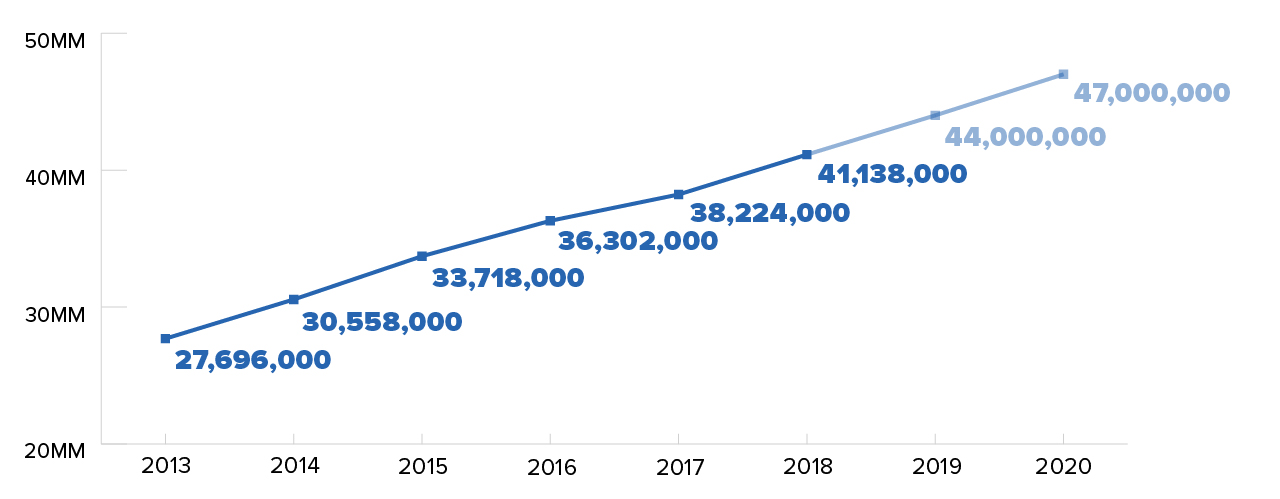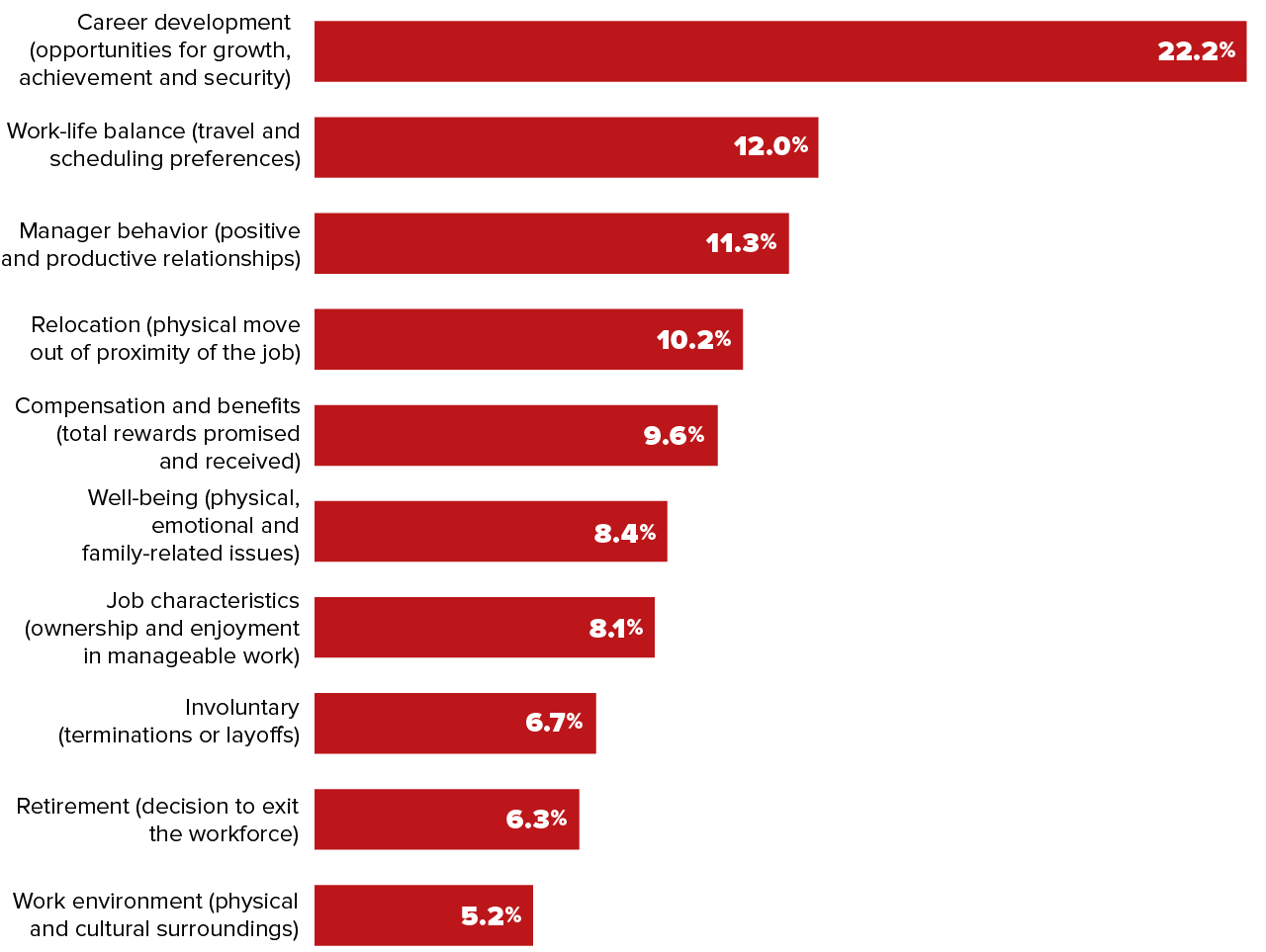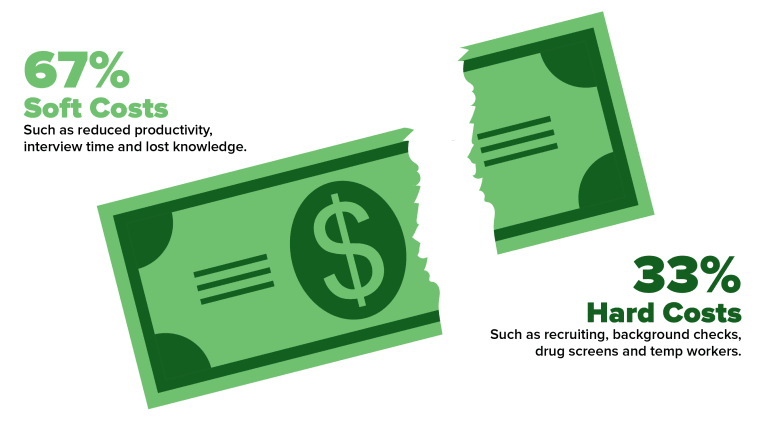Reducing Employee Turnover with Creative Workplace Solutions
Amid one of the tightest labor markets in the past 50 years, employee retention is more critical than ever.

Not many companies would boast about a 90 percent annual employee turnover rate, but it's a real point of pride at Kum & Go, a convenience store chain in the Midwest. Such enthusiasm is understandable, considering that two years ago the annual benchmark for hourly worker turnover was more than 160 percent.
The constant churn took its toll on the bottom line, as the company was forced to pay employees overtime to cover vacant shifts. Working extra hours annoyed some staffers, prompting them to quit and compounding the problem. And replacing each hourly worker cost an average of $1,500.
"It was a real snowball effect," says Jon Renaud, director of operations at the Des Moines, Iowa-based retailer with 407 stores at gas stations in 11 states, primarily in Iowa. A combination of new technology and improved benefits, such as spot bonuses and birthdays off with pay, led to better employee engagement and a lower turnover rate, which continues to drop.
"We're fighting using every step and tool we can," Renaud says. "You have to position yourself as a desirable employer."
Employee retention has taken on a new significance amid one of the tightest labor markets in the past 50 years. In January, the unemployment rate stood at 4 percent. The robust job market has given employees the confidence to seek new opportunities, while employers are wrestling with rising compensation and heated competition for new hires, both salaried and hourly.
The Financial Impact of Employee Turnover
An estimated 41 million people voluntarily quit their jobs last year, up 8 percent from 2017, according to the Work Institute, a Franklin, Tenn.-based consulting firm. By 2020, that number will jump to 47 million, or roughly 1 in 3 workers, the firm predicts.
"Employers continue to believe that they're in control of employment relations, but with the current economic condition, employees are squarely in control," says Danny Nelms, president of the institute. "Employees are sellers in a sellers market."
The business ramifications are enormous. Each employee departure costs about one-third of that worker's annual earnings, including expenses such as recruiter fees, temporary replacement workers and lost productivity, according to the Work Institute.
To engender loyalty, companies are trying every tactic, from raising salaries to bolstering benefits to offering more training and education. That last category is becoming critical: Inadequate career development is the leading reason people leave their jobs, the institute reports, with 21 percent of those interviewed citing it as the driving factor. Those employees expressed frustration with the lack of growth, development opportunities and advancement in their jobs.
Moving On
An estimated 41 million people voluntarily quit their jobs last year, up 8 percent from 2017, according to the Work Institute, a Franklin, Tenn.-based consulting firm. By 2020, that number will jump to 47 million, or roughly 1 in 3 workers, the firm predicts.

Source: U.S. Bureau of Labor Statistics; Work Institute. 2018 figure is estimated; 2019 and 2020 figures are projected.
Enhancing Employee Benefits for Mutual Success
Professional services firm PricewaterhouseCoopers (PwC) has always offered employees a generous benefits package, but amid the tight labor market, the company has been looking for ways to improve it. That includes providing extended holiday breaks and more educational opportunities.
"Are we concerned about the market? We are 100 percent concerned," says Rod Adams, the firm's U.S. and Mexico talent acquisition leader.
Last year, for the first time, PwC gave its employees the entire week of July Fourth off, with pay. It already does so for the week between Christmas and New Year's. PwC also began providing various types of digital training to its employees to expand their knowledge in such fields as artificial intelligence and data insights. The idea isn't to make employees topic experts, but rather to broaden their knowledge to better serve clients.
"We know our people need these skills, and we know they want them," Adams says. He adds that he hopes PwC's employees grow more attached to the firm for recognizing their desire for more knowledge and training.Creating a career blueprint is the hallmark of a two-year effort to make Indiana University Health a better place for nurses to work. The Indianapolis-based health system has lowered its annual nursing turnover rate to 13 percent, compared with the national average of 15 percent.
After they've spent a year at the institution working in various areas, nurses at the health system select a professional pathway to pursue. They can choose from a wide array of options, including management, research and quality control, and the hospital provides support such as mentoring, tuition reimbursement and e-learning classes, to help them meet their goals. "They know that if they go to other institutions, they won't have that opportunity," says Michelle Janney, chief nursing officer of the 16-hospital system.
The IU Health system has also raised its education allowance for nursing degrees from $3,600 to $5,250 a year. Nurses with associate degrees were previously told that if they didn't earn a bachelor's degree within two years, they would be terminated. That rule has been eliminated.
Reducing turnover can have a major impact on hospitals' finances. Each percentage change in registered nursing turnover will cost, or save, the average hospital $337,500. Nurse departures cost the average hospital $4.4 million to $7 million in 2017, according to Nursing Solutions Inc., a staffing agency.
Turnover for nurses is highest in the first year at a new job. That prompted Indiana to require managers to hold quarterly "stay conversations" with new nurses in the hopes of addressing any issues before they become major problems. Now at Indiana the first-year turnover rate is 15 percent, compared to the national average of 20 percent. "We have planned interventions to help them over the hump," Janney says.
The hospital system also redesigned its orientation process, creating teams of nurses who joined at the same time to automatically give them a sense of community. They participate in group activities, such as scavenger hunts, that make training more fun. And now, thanks to a relaxed dress code (down from 80 pages to five), once-forbidden forms of self-expression like visible tattoos and hair dyed unconventional colors are acceptable. "We were conducting orientations like we did 20 years ago," Janney says.
Why People Quit
The leading reasons why employees left their jobs in 2018.

Source: Work Institute.
Challenges and Solutions in High-Turnover Industries
Companies in other industries plagued by high turnover have also been reassessing their practices to help retain employees. But success has remained elusive for some.
ECCO USA Inc., a Londonderry, N.H.-based chain of 80 stores that sell footwear, bags and other accessories, changed its compensation practice two years ago from salary and commission to straight salary. Sales associates had expressed a desire for more-stable paychecks, says Cheryl Garrison, SHRM-SCP, HR director of the company, which is a division of a family-owned Danish firm. That year ECCO also hired a new head of retail, resulting in major turnover among its sales managers.
Last year, ECCO stopped tying bonuses to overall store sales and began linking them to outcomes that are more within staffers' control. Managers, for example, may be judged on how well they handle payroll costs, and salespeople can earn bonuses by turning browsers into buyers. "You can't control how many people go into a store," Garrison says.
ECCO also provides store employees with additional training to prepare them to advance into higher positions when openings become available. As part of this effort, staffers are given new responsibilities for a limited time to broaden their expertise. Sales associates may order socks or create staffing schedules, for example. The company also created a special leadership development program to groom some store managers to become district managers.
Perhaps most importantly, ECCO raised salaries after a study it commissioned showed that its pay was lagging the competition's. "We didn't want to be known as a minimum-wage employer," Garrison says.
Last year, retail turnover at ECCO fell to 72 percent from 85 percent in 2017. In 2016, the rate was 74 percent. Garrison said the pinch from the turnover intensified in 2017, and it took time for the company to establish and implement programs to address the situation. Still, ECCO's turnover remains above the industry mean of 61 percent—the highest of any job sector, according to consulting firm Mercer. Eventually, Garrison would like to see the company's rate match or fall below the mean. But she notes that the industry will always have high turnover as so many people work in stores only to put themselves through school or earn pocket money, without any intention of making retail their career.
U.S. Turnover Rates by Industry
| Industry Sector | Average Turnover |
|---|---|
| Retail & Wholesale | 60.5% |
| Other Manufacturing | 26.7% |
| Consumer Goods | 21.5% |
| High-Tech | 20.9% |
| Transportation Equipment | 20.4% |
| Services (Nonfinancial) | 17.4% |
| Logistics | 16.8% |
| Other Nonmanufacturing | 16.3% |
| Banking/Financial Services | 16.0% |
| Insurance/Reinsurance | 15.5% |
| Life Sciences | 14.5% |
| Chemicals | 12.6% |
| Energy | 11.8% |
Source: 2018 Mercer US Turnover Survey of 163 U.S. organizations. Data provided is the number of voluntary, involuntary and retirement separations in 2017.
Strategies to Overcome Employee Retention Challenges
Companies in competitive industries and markets face a never-ending quest to find the right mix of benefits to retain workers. It's tricky because so many offer the same perks, such as 401(k) matches, free food, unlimited vacation and flexible work schedules. It's not just pure tech firms in such areas that are concerned; every company requires tech-savvy employees. But employee retention has taken on new urgency in places like New York City, where firms such as Facebook, LinkedIn and Google already have a major presence, with Google rapidly expanding.
"That's a lot more competition for talent," says Amy Stoldt, vice president for people at New York City-based Peloton, maker of indoor exercise bikes with live-streaming and on-demand classes. Peloton has about 150 software engineers among its 1,500 employees and plans to add more this year.
Last year, Peloton hired a head of benefits and compensation to make sure it was rewarding all its employees appropriately. The average Peloton employee is 29 years old, and Stoldt says the company is experiencing a baby boom. It therefore also added a 529 plan so that employees can set aside money to pay for their children's college tuitions. It already offers employees a college-loan repayment program to help them reduce their educational debt. Now it's considering increasing its 401(k) match beyond 4 percent and extending paid parental leave beyond 12 weeks.
Peloton also promotes other, less-tangible benefits to improve retention, such as the company's relatively small size, which gives employees opportunities to broaden their responsibilities and experience. "Here you can own a project," Stoldt says. "You're not a cog in a wheel."
Longevity brings the potential for more financial remuneration at Peloton. The company offers employees equity that vests after four years. "That could be substantial," Stoldt says.
That's not a draw that's available at most companies. A family-owned firm like Kum & Go doesn't offer stock options. It can't even match the perks available to part-time workers at McDonald's, Starbucks or Walmart.
Realizing that it couldn't reduce its turnover rate through costly perks and benefits, Kum & Go centered its strategy on making the company a nicer, more engaging place to work. "Convenience store work is tough," Renaud says. "You're on your feet eight hours a day. We needed to make our associates' days better."
Management now posts signs in the stores that praise employees for their efforts. The company also started to use Branch, a mobile scheduling app for hourly workers. Renaud says Branch allows employees to more easily find available shifts across numerous stores so that they can sign up for hours that fit their schedule. "Young folks want to work when and where they want to work," Renaud says. "We're giving them that flexibility."
He says the ease of using the app has led employees who were working only 16 to 18 hours a week to increase their workweek to up to 24 hours. That has helped the company apportion employees' hours more equally and cut overtime expenses by 25 percent.
Renaud says there wasn't one change that led to the dramatic drop in turnover: "It's about engaging with employees full time, all the time."
The Cost of Replacement
The business ramifications of employee turnover are enormous. Each departure costs about one-third of that worker’s annual earnings. Here’s where that money goes:

Source: Work Institute.
Building an Engaging and Supportive Work Environment
Creating an environment in which employees want to work and feel valued is a core philosophy at fast-food chain Pal's Sudden Service. That's why the turnover rate for hourly workers at the Kingsport, Tenn.-based chain of 29 drive-throughs is a remarkable 23 percent—about one-third of the industry average.
Company President Thom Crosby says it's imperative that businesses set the stage for engagement, and at Pal's that means providing employees with safe, clean workplaces where the equipment always functions. "You have to get the environment right," he says. "You know that someone really cares about you if they're taking the time to get your facility right."
Training is a crucial element, too. Employees spend hours learning all the functions in the restaurant and are tested on their knowledge. They must receive a perfect score to be certified to work at a particular station and are randomly retested throughout the year.
Managers are also expected to teach employees skills that go beyond making hot dogs and hamburgers. Crosby says employees are taught the importance of good personal grooming and communication skills—knowledge that will help them long after they leave Pal's.
Employees also receive regular assessments of the company's sales and profits so that they can draw a connection between their work and the larger picture. "It's not fun to play the game if you don't know the score," Crosby says. "Employees want to be part of the conversation. "
Theresa Agovino is the workplace editor for SHRM.
Explore Further
SHRM provides resources to help companies more effectively retain their employees:
Book Blog: Driving Engagement and Retention
Nothing an organization does contributes more to productivity than improving employee engagement and retention by getting employees to give their best. No administrative task such as making payroll, no hiring task such as filling jobs quickly, and no program task such as planning employee appreciation days equals this all-important mission. Nothing. But HR can't improve engagement and retention alone.
SHRM Toolkit: Managing for Employee Retention
Strategic action is needed to keep employees motivated and focused so that they stay employed and fully productive. A comprehensive employee retention program can play a vital role in attracting key employees, as well as in reducing turnover and its related costs.
How Do I Calculate Retention?
Many employers use the terms "retention rate" and "turnover rate" interchangeably, while others feel one is simply the inverse of the other. In fact, the retention rate, sometimes referred to as the "stability index," measures the retention of particular employees over a specified period and complements the turnover rate metric, giving a more complete view of worker movement than calculating either metric alone.
Stay Interview Questions
Stay interviews are conducted to help managers understand why employees stay and what might cause them to leave. In an effective stay interview, managers ask structured questions in a casual and conversational manner, which rarely requires more than 30 minutes.
SHRM Toolkit: Developing and Sustaining Employee Engagement
The term "employee engagement" relates to the level of an employee's commitment and connection to an organization. Employee engagement has emerged as a critical driver of business success in today's competitive marketplace. High levels of engagement promote retention of talent, foster customer loyalty, and improve organizational performance and stakeholder value.



